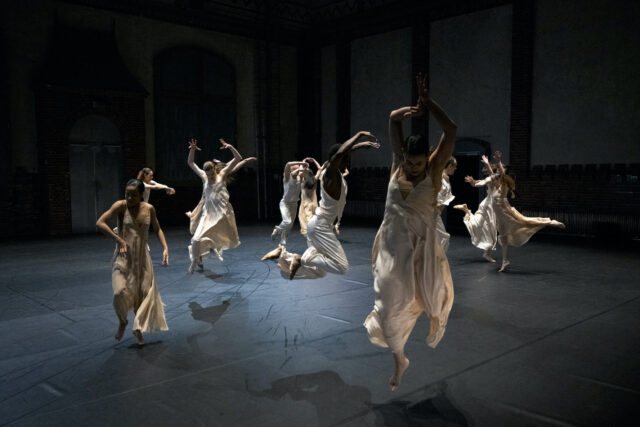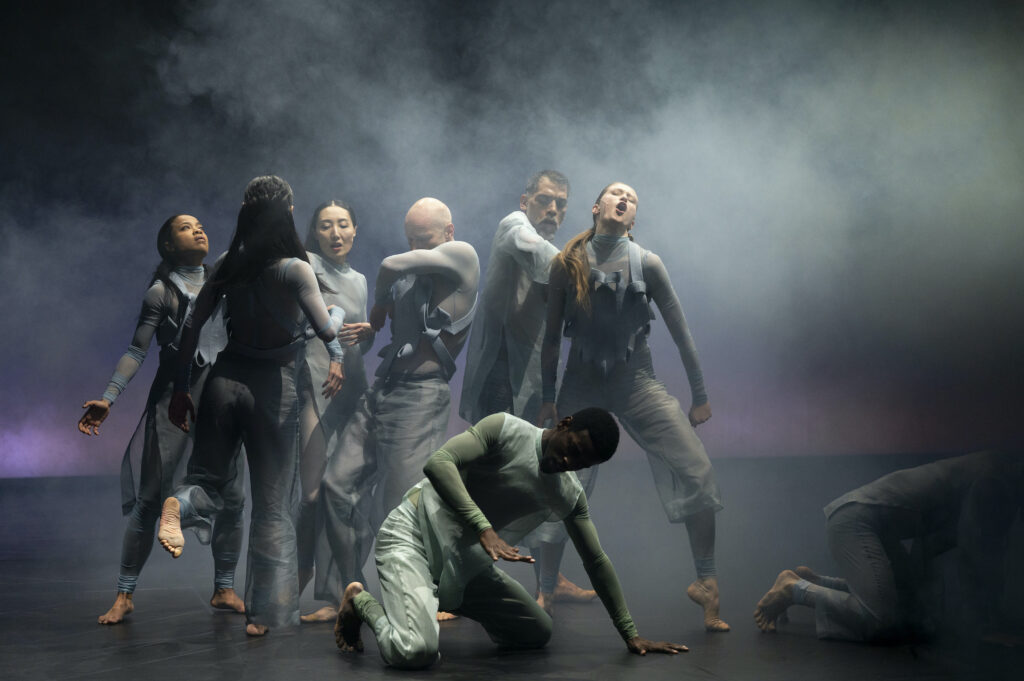
For the English version, please, scroll down
BERLINO – L’11 marzo del 2023 a Berlino, presso il Radialsystem, ha debuttato Beethoven 7 di Sasha Waltz.
Già nel 2021 in Grecia, nell’antico sito archeologico di Delphi, la compagnia della coreografa tedesca aveva danzato due movimenti della settima sinfonia di Beethoven per l’emittente televisiva ARTE (Association relative à la télévision européenne). Nella versione attuale, la coreografia è più ampia, arrivando a ricoprire tutti e quattro i movimenti della celeberrima Opera sinfonica. Oltretutto adesso viene preceduta da una prima parte accompagnata dalla musica che il compositore cileno Diego Noguera esegue dal vivo.
Le bellissime maschere del designer Federico Polucci
Avvolte da una fitta nuvola di fumo, alcune creature pirandelliane, il cui capo è coperto dalle bellissime maschere del designer Federico Polucci, avanzano con andatura lenta. La loro entrata è resa ancor più suggestiva dall’effetto creato dalla luce proiettata nella parte bassa del fondale, che rende i corpi dei danzatori eleganti sagome nere aumentando, così, la sensazione di mistero ed estraneità. Dopo un momento di buio totale, ritorna la luce e sul palco compaiono anche altri performer, ma questa volta, tutti mostrano il loro viso. Segue un altro blackout, e quando la danza riprende, i movimenti iniziano ad essere veloci.
Sul palco l’azione è più concitata. Questi individui, che, senza maschere sembrano smarriti, si raggruppano e, quando il ritmo della musica aumenta, iniziano a danzare una coreografia più strutturata. È come se l’appartenenza al gruppo gli conferisse maggiore sicurezza. In questa fase i movimenti sono più ‘scattosi’ e frammentati, per poi diventare frenetici. Ancora una volta si compattano e, camminando all’indietro, scompaiono dietro il palco, inghiottiti dal fumo.
Nella seconda parte, dopo la pausa, i tredici ballerini della Sasha Waltz & Guests rientrano sul palco con fluttuanti abiti color rosa pallido.
Il fascino del continuo cambio di costumi
In questo caso, la danza è perfettamente costruita sul ritmo della musica di Beethoven, che risuona nella versione diretta da Teodor Currentzis. La coreografia è caratterizzata da una geometria che dà la direzione alle camminate e alle corse sul palco. I passaggi sono fluidi, leggeri e ‘ispirati’ come la sinfonia che Wagner definì “apoteosi della danza”. Prima di ogni ‘movimento’ i danzatori, escono di scena, ricomparendo sempre con costumi differenti. La danza con l’aumentare dell’intensità della musica, diventa sempre più lirica e drammatica. Alcune scene suggestive colpiscono l’attenzione degli spettatori, come quando viene sventolata una bandiera di un colore perlaceo che fluttua nell’aria con l’andamento e le increspature di un corso d’acqua o quando tutti i danzatori si raggruppano con le braccia alzate verso l’alto.
Una coreografia che ha due anime
La dualità di questa produzione rappresenta la sintesi di due aspetti riconoscibili del lavoro di Sasha Waltz. La prima parte, infatti, è caratterizzata dall’improvvisazione e da una drammaturgia più ‘astratta’ che richiama alla mente produzioni come Kreatur, mentre la danza della seconda parte ricorda le coreografie create per le Opere liriche. Entrambe i pezzi, comunque, sono accomunati da un simile uso dello spazio e da ripetuti intervalli che consentono i cambiamenti che seguono a entrate e uscite di scena.
Beethoven 7 è uno spettacolo che, grazie anche alla musica, alle luci, ai costumi e alla bravura dei danzatori, è di forte impatto visivo, di grande forza scenografica e d’intensità emotiva.

On March 11th 2023 in Berlin, at the Radialsystem, Beethoven 7 by Sasha Waltz debuted.
Already in 2021 at the ancient archaeological site of Delphi, Greece, the German choreographer’s company danced two Beethoven’s seventh symphony movements for ARTE (Association relative à la télévision européenne), the television station. In the current version, the choreography is wider, covering all four movements of the famous symphonic work. Moreover, it is now preceded by a first part accompanied by music that the Chilean composer Diego Noguera performs live.
Wrapped in a thick cloud of smoke, some Pirandellian creatures, whose heads are covered by the beautiful masks by the designer Federico Polucci, advance at a slow pace. Their entrance is even more suggestive thanks to the effect created by the light projected in the lower part of the backdrop. The dancers’ bodies appear as elegant black shapes, increasing the feeling of mystery and extraneousness. After a moment of total darkness, the light turns on again and more performers appear on stage, but this time, they all show their faces. Another blackout follows, and when the dance resumes, the movements begin to be faster. On stage the action is more animated. These individuals, who seem lost without masks, gather together and, when the rhythm increases, begin to dance a more structured choreography. It is as if belonging to the group gives them more security. In this phase the movements become more ‘jerky’ and fragmented until they get even frenetic. Once again the dancers gather and, walking backwards, they disappear behind the stage, swallowed by the smoke.
In the second part, after the break, the thirteen dancers return to the stage in billowing pale pink dresses.
The dance is perfectly built on Beethoven’s music beats, in the version conducted by Teodor Currentzis. The choreography features a geometry that gives direction to the walks and runs on stage. The passages are fluid, light and ‘inspired’ like the seventh symphony that Wagner called the “apotheosis of dance”. Before each ‘movement’ the dancers leave the stage, always reappearing with different costumes. As the intensity of the music increases, the dance becomes more and more lyrical and dramatic. Some evocative scenes strike the attention of the audience, such as when a flag of a pearly color is waved and floats in the air with the flow and ripples of a stream or when all the dancers gather with their arms raised towards the high.
The duality of this production represents the synthesis of two recognizable aspects of Sasha Waltz’s work. The first part, in fact, is characterized by improvisation and a more ‘abstract’ dramaturgy that reminds productions such as Kreatur, while the dance of the second part recalls the choreographies created for operas. Both pieces, however, have in common a similar use of space and the repeated intervals that allow the changes that follow stage entrances and exits.
Beethoven 7 is a show that, thanks also to the music, the lights, the costumes and the skill of the dancers, has a strong visual impact, great scenographic strength and emotional intensity.














































